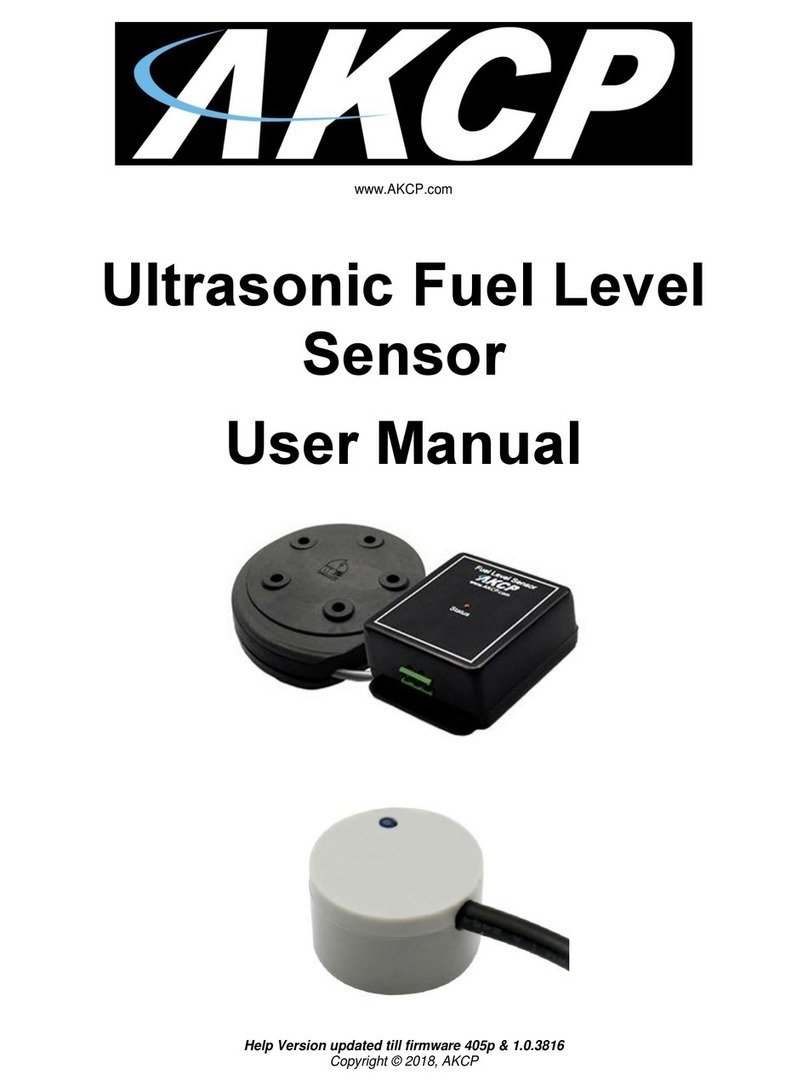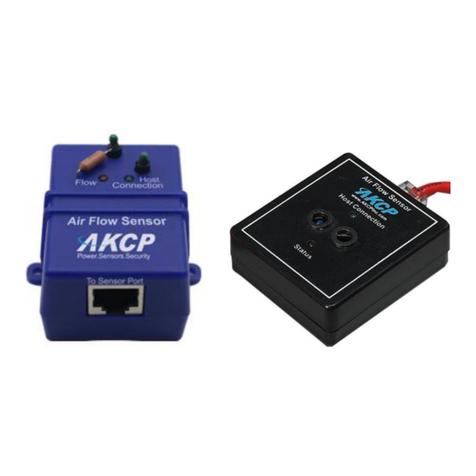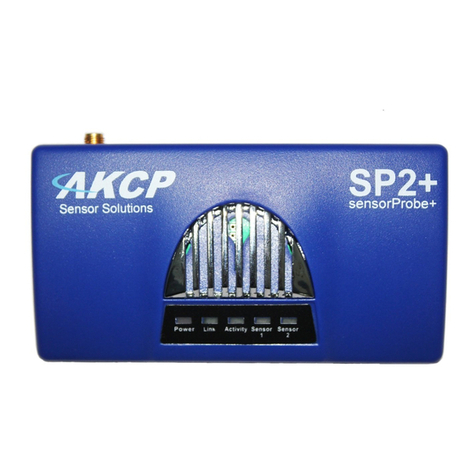AKCP ropeWater User manual

www.AKCP.com
ropeWater Sensor
Copyright © 2014, AKCess Pro Co., Ltd..

ropeWater Detector
- 2 -
Table of contents
1. Introduction
2. Features
3. Configuring the ropeWater sensor
4. Configuring the ropeWater sensor on a sensorProbe unit
5. Configuring the ropeWater sensor on a securityProbe or a securityProbe 5E unit
6. Detection of Acid
7. Mounting the ropeWater sensor impedance setting & trouble shooting
Introduction
Water can enter a building in many different ways and, in some cases, remain undetected. This
can cause damage and problems to sensitive electronic equipment. Computer and mainframe
rooms which have a false floor and ceilings could harbor undetected water, which is only detected
after a problem occurs.
The ropeWater sensor is capable of detecting the presence of or non-presence of water. It
contains a microprocessor controlled capacitance measuring circuit which is far more precise
than commercially available standard water detectors which measure the resistance of water.
The detector provides feedback to the web based interface which will indicate the
presence/absence of water with a Normal/Alert, or Critical indication. The unit will retain any error
condition until it is read via a snmpget. Therefore, if it encounters a critical condition at any time, it
will report that condition before it returns to a normal state.
The value of the status for the SNMP OID for the ropeWater sensor can be Normal, No Status,
Critical or Sensor Error.
ropeWater sensor OID:
For a switch type sensor on RJ45#1 the OID for the status is .1.3.6.1.4.1.3854.1.2.2.1.18.1.3.0
Features:
oOn/Off alarm signal of Water detected
oAccurate, cost effective Water detecting system
oRope portion of the sensor is submersible
oSensor type - open/closed contact switch
oPower source: powered by the unit. No additional power needed.
oPower Consumption: Typical 125 mWatt, 25 mA
oThe unit auto detects the presence of the ropeWater sensor
oUp to 2 ropeWater sensors per unit sensorProbe2.

ropeWater Detector
- 3 -
oUp to 8 ropeWater sensors per unit sensorProbe8.
oHundreds of ropeWater sensors per securityProbe 5E and E-sensor8 E-modules
oFull Autosense including disconnect alarm if cut, broken, or disconnected
oSensing rope cable can be pre-ordered from a 10 foot minimum to any custom run
length of up to 165 feet or 50 meters.
oNon-sensing cable comes in a standard 20 foot run length.
oCan be connected to any of the sensorProbe or securityProbe’s 8 RJ-45 Intelligent
sensor ports or any of the securityProbe 5E’s E-sensor8 expansion module ports.
oCan be extended up to 100 feet, or 30 meters using normal CAT5\6 LAN cable from
the RJ-45 sensor ports.
oMeasurement range: Wet or Dry (-20 degrees C- +60 degrees C)
oComes fully assembled and includes the rope portion that is the water sensing cable,
the non-sensing area cable (from the rope to the sensing module) and the main
sensing module.
ropeWater sensor product assembly diagram
Configuring the ropeWater sensor
a) Plug the sensor into one of the RJ45 ports on the rear panel of the unit or expansion module.

ropeWater Detector
- 4 -
b) Now point your browser to the IP address of the unit (default, 192.168.0.100). Next you need
to login as the administrator using your administrator password (default is “public”). You will then
be taken to the summary page.
c) From the summary page you need to select the sensors tab. The layout of the next page will
vary depending on your unit so please refer to your unit’s manual.
d) You should now be able to setup the thresholds for your sensor. The low critical, low warnings,
normal, high warnings, high critical values can be set from this page.
Now we will cover the settings that are specific to your sensor.
Status: If the sensor is offline, the status is No Status. If the sensor is online, and there is no
water detected, the status is Normal. If water is detected, then the status is Critical. If at any time
communications with the ropeWater sensor are lost, the status of the ropeWater sensor is
changed to Sensor Error.
Configuring the ropeWater sensor on a sensorProbe unit
The ropeWater sensor shows the “Normal” status in Summery page after connecting the sensor.
Use the Sensors page and the Water Detector sensor settings in the sensorProbes web interface
for configuring the ropeWater sensors settings.
The ropeWater sensor shows the “Critical” status in the Summery page after detecting water.

ropeWater Detector
- 5 -
Configuring the RopeWater sensor on a securityProbe or a securityProbe
5E unit
The ropeWater sensor shows the “Normal” status in Summery page after connecting the sensor
and when water is detected is will show “Crtical” in this page and the syslog:
Use the Sensors page and the Water Detector sensor settings in the sensorProbes web interface
for configuring the ropeWater sensors settings.

ropeWater Detector
- 6 -
Detection of Acid
In power monitoring situations where backup battery and UPS are used to ensure a constant
power supply there is a risk of battery’s leaking harmful battery acid. Use this rope sensor
underneath backup battery banks to give advanced warning of battery acid leaks.
Note: This product is designed for short term exposure to battery acid only. Tested with 40%
concentrate Sulphuric acid (H2SO4)
Mounting the ropeWater sensor
We recommend using any standard plastic U-clip or half U-clip with the adhesive base as shown
in these two pictures below. These types of clips can normally be found at your local hardware
store.
When installing or handling your new rope sensor, please be sure to handle the rope portion of
the sensor with care, avoiding any twisting, excessive bending or putting stress on the rope, as
the internal sensing wires are very delicate and can become damaged quite easily.

ropeWater Detector
- 7 -
Notes on sensitivity and status changes
Keep in mind the rope water sensors “wet”to “dry”status change (critical condition to normal
condition) can take up to 30 minutes after the sensor has been in contact or submerged in water,
even when the rope is wiped dry as there could still be water present within the inner windings of
the rope cable.
Also, this is due to high sensitivity of the rope. The sensor modules internal computation and
update to the base unit's web interface also has a factor in the time it takes to update the sensor
status from the “wet” or critical condition back to the “normal” or non-critical condition.
Trouble Shooting the ropeWater sensor
The rope type sensors are sensitive to EMI and also metallic or conductive items and surfaces.
So they should not be installed on a metal floor for example. They also should not be installed
where they will be in direct contact with metal piping or installed hear power equipment.
We highly suggest you first test the rope water sensors before they are installed to ensure that
they work when removed from the packaging.
If you receive sensor errors in the web interface of the unit when first connecting the sensors here
are some steps to take:
1. Check the 4 wires which are screwed to the Green terminal block. See below picture. Sometimes these can become
loose during shipment.

ropeWater Detector
- 8 -
2. Check the tail connector contacts if they are not damaged. After checking, reconnect them together as shown in the
picture below.

ropeWater Detector
- 9 -
3. Continuity Test. Refering to the picture of the connector above. Disconnect the module from the green terminal block
then using a multimeter:
A. Measure the resistance between A-B.
B. Measure the resistance between A-C.
C. Measure the resistance between A-D.
D. Measure the resistance between B-C.
E. Measure the resistance between B-D.
F. Measure the resistance between C-D
Recheck A-B with a multimeter. The value should be near C-D. A-B should not be infinite otherwise it will return a sensor
error. Please send these testing results to support@akcp.com and include the length of the rope and the serial # which is
located on the side of the black electronics module.
Notes on the Impedance and Sensitivity of the ropeWater Sensors
The rope sensors come with the impedance value in the package. If they don’t have this then this is how it is calculated:
Regarding the sensing impedance, please find below the instruction to calculate it for more custom value.
Sensing Impedance = [ (Rope resistance between pin 1 and 2 + Rope resistance between pin 3 and 4) / 2] / Water Rope
length in meter
Pin 1 is the red wire on the green phoenix connector and pin 4 is the yellow wire.

ropeWater Detector
- 10 -
The sensitivity of the sensors is not adjustable. All sensors are tested before shipment using a damp sponge.
There's no point changing the sensing impedance value for the RWS on the web interface. Although we do measure the
individual resistance of each wire to compute the impedance value of the rope during our production process & testing
prior to shipment, it is done to make sure that the impedance is within the module's acceptable working range. For the
Locate ropeWater Sensors, the value is printed on a sticker which goes to the tail connector and to a quick start guide for
setting it up on the web UI.
In a good operational RWS the connections should be well intact and the status should be showing Normal in the web UI.
You can test this by disconnecting the Green terminal block from the module (black box). The Red LED of the module
should turn on and the status should change to critical. Plug the Green terminal block back in place then wait for the Red
LED to turn off. Then wet the yellow or blue cable with water not the Orange cable.
Notes on the Rope Types of the ropeWater Sensors
We changed to a new supplier of the rope in 2012 which is of better quality than the previous rope type we used.
Please see the picture avolve that shows the two different rope types. The blue colored rope is the previous rope type we
used. The product codes were RWSTXX (sensor), RWSTCABXX (extensions), LRWSTXX and LRWSTCABXX.
The new rope type sensors product codes are now RWSCXX, RWSCCABXX, LRWSCXX and LRWSCCABXX. This is the
yellow colored rope in the picture attached.
Our production manager has confirmed that both types of rope water sensor extensions (RWSTCABXX and
RWSCCABXX) are compatible and nothing else changed on the sensor, just the rope type.
This concludes the AKCP ropeWater Manual.
Please contact support@akcp.com if you have any further technical questions or
problems setting up your modem or your alerts.
Thanks for Choosing AKCP!
Other AKCP Accessories manuals






















